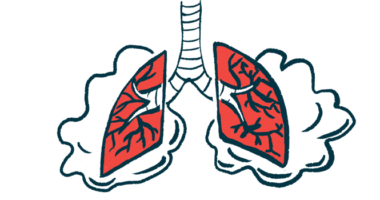Nomogram may be used to predict worse lung scarring in SSc-ILD
Tool could help ID patients who would benefit from close monitoring

A prediction tool known as nomogram may be used to calculate the chance of a person with systemic sclerosis (SSc) and interstitial lung disease (ILD) developing progressive pulmonary fibrosis, or worsening lung scarring, a new study suggests.
The nomogram essentially is a pictorial representation of a complex mathematical formula. Here, it crossed information about sex, blood levels of CXCL4 — a biomarker for ILD — and acid reflux to predict the likelihood of progressive pulmonary fibrosis in the two years following immunosuppressive treatment with mycophenolate mofetil or cyclophosphamide.
It has yet to be validated for use in the clinic, but the researchers say the nomogram “could identify patients with SSc-ILD who would benefit from closer monitoring of their response to the initial treatment approach.”
The study, “Combining Clinical and Biological Data to Predict Progressive Pulmonary Fibrosis in Patients With Systemic Sclerosis Despite Immunomodulatory Therapy,” was published in ACR Open Rheumatology.
No prediction tool exists for lung scarring in SSc-ILD
Ssc, also called scleroderma, results in thickened, hardened skin and also may involve fibrosis or scarring that forms around blood vessels and in the body’s internal organs. When this happens in the lungs, it can cause disorders like ILD.
In ILD, scarring causes the lungs to become stiff, which can make it difficult to breathe and get oxygen into the bloodstream. Over time, many people with SSc-ILD will go on to develop progressive pulmonary fibrosis.
While progressive pulmonary fibrosis is the leading cause of death among people with SSc, predicting who is more likely to experience worsening lung scarring can be challenging.
“No valid clinical prediction tools exist for predicting [progressive pulmonary fibrosis] among patients with SSc-ILD who are already receiving …. treatment,” the researchers wrote.
To meet this challenge, the scientists developed a nomogram based on information from 112 patients who took part in the Scleroderma Lung Study (SLS) II (NCT00883129), conducted across more than a dozen U.S. locations. Participants received either mycophenolate mofetil for two years or cyclophosphamide for one year.
Throughout the second year, 22 patients met the criteria for progressive pulmonary fibrosis, meaning they had at least two of the following symptoms: worsening breathing, worsening lung function, and/or X-ray evidence of disease worsening.
Half were treated with mycophenolate mofetil and the other half with cyclophosphamide. The proportion of men among those who developed progressive pulmonary fibrosis was significantly higher than that of women (33.3% vs. 14.6%).
At baseline, or entry to the study, participants who developed progressive pulmonary fibrosis also tended to have lower blood CXCL4 (mean 10.76 vs. 11.22 log base 2, or log2) and higher (worse) GIT 2.0 scores (mean 0.8 vs. 0.55 points). GIT 2.0 is a measure of acid reflux, a common symptom of SSc.
It also was more common for those who developed such lung scarring to stop their treatment before it was completed (50% vs. 16.7%). This most commonly was due to side effects or an overlapping disease.
Being male, having lower blood CXCL4, and scoring higher on GIT 2.0 all were linked to an increased risk for progressive pulmonary fibrosis.
New tool must be validated in future studies
Based on these predictive factors, the researchers developed a nomogram specifically for use in these patients.
When using the nomogram, each predictive factor is assigned a score from 0 to 100 points. The chance of having progressive pulmonary fibrosis in two years was calculated by matching the sum of all scores to a probability ranging from 5% to 80%.
The nomogram performed moderately well, with a C-index of 0.72. The C-index is a measure of how well a model can tell those who experience an event from those who don’t. A higher C-index indicates better predictive performance.
“If validated in future studies, this nomogram or further iterations of it could be applied in clinical practice to identify patients with SSc-ILD who require careful monitoring during therapy,” the researchers concluded, adding that different nomograms may be needed for medications other than mycophenolate mofetil or cyclophosphamide.
Among the study’s limitations, the team mentioned noted that the results “may not be directly generalizable to patients who were not preselected for specific criteria and enrolled in a clinical trial.”








